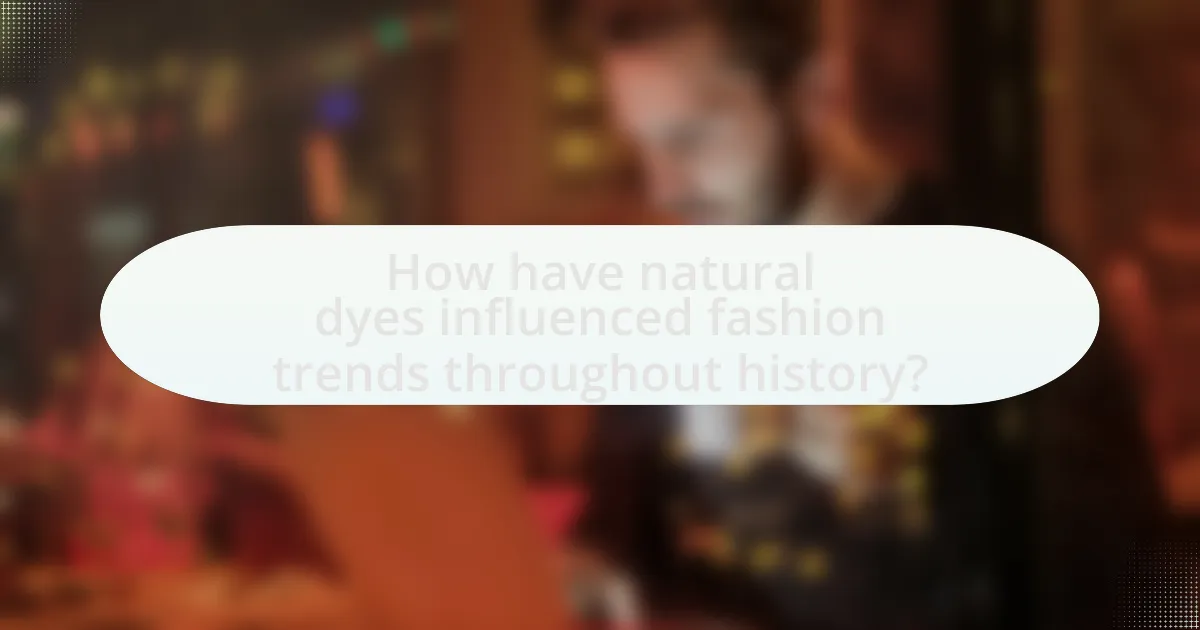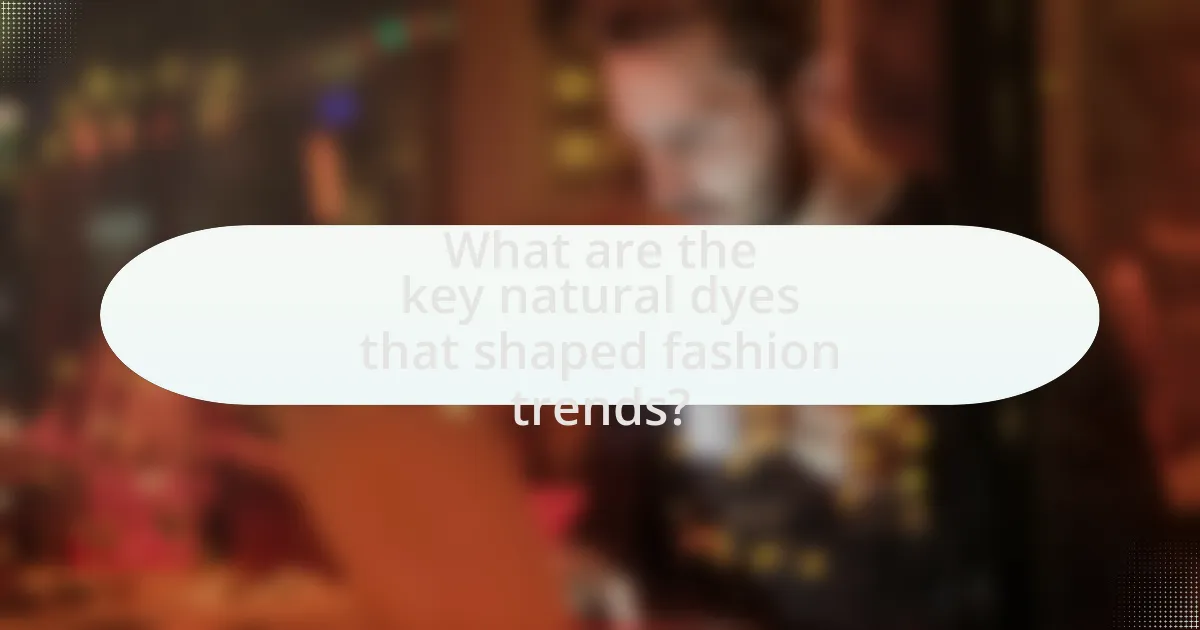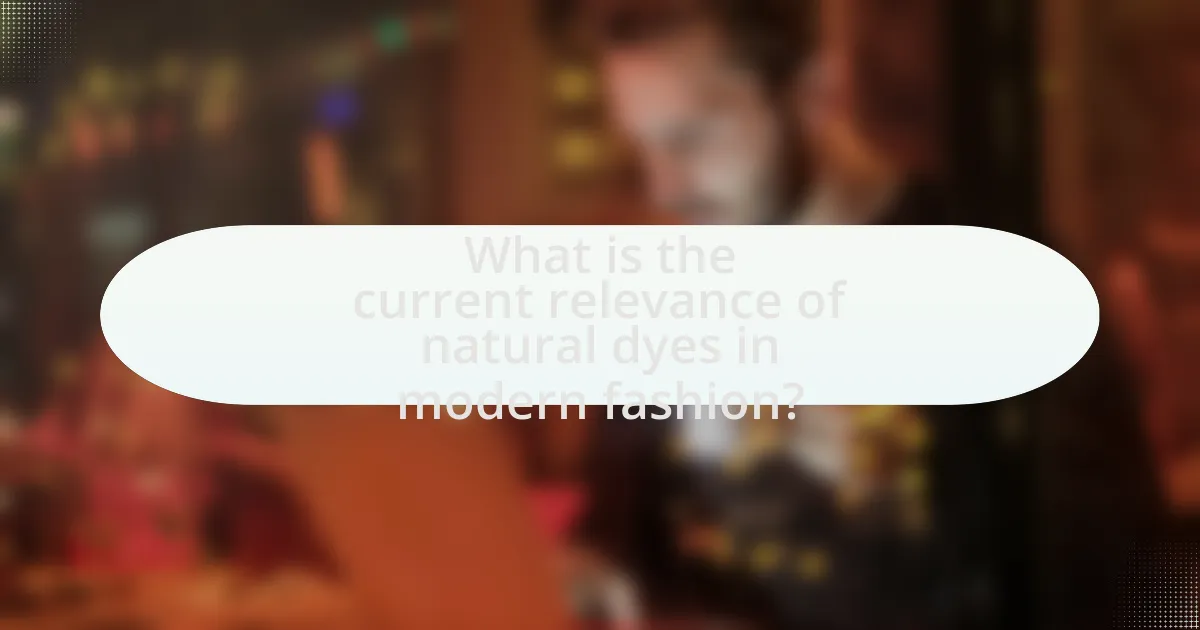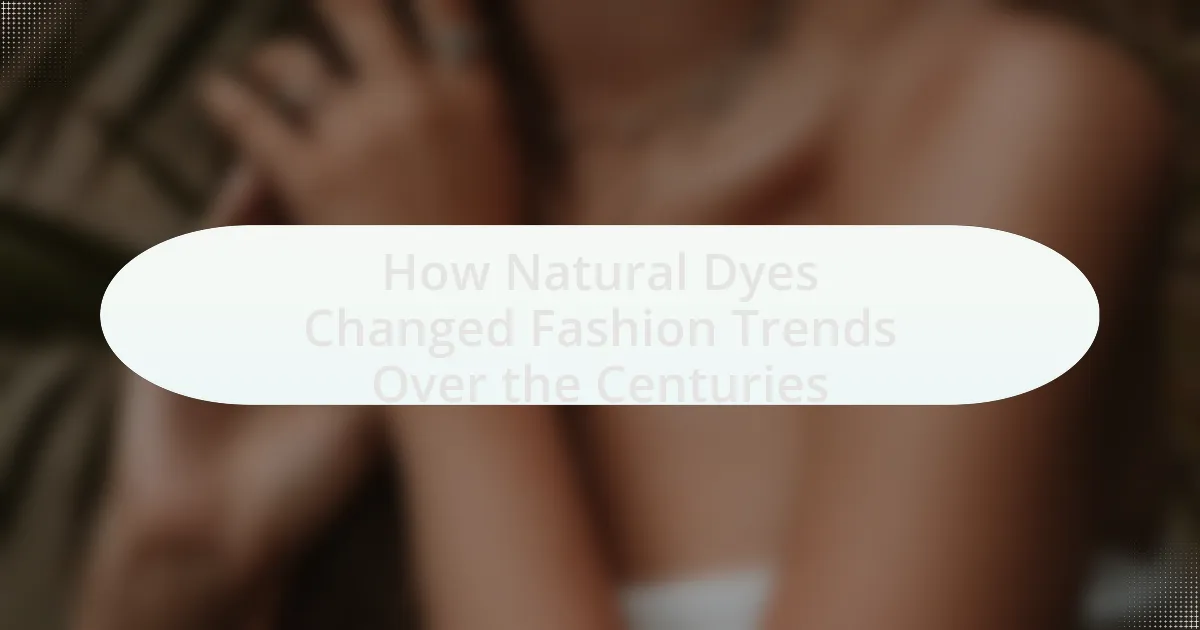Natural dyes have played a crucial role in shaping fashion trends throughout history, influencing color palettes and cultural expressions from ancient civilizations to modern times. The article explores the origins of natural dyes, their sourcing and processing methods, and their cultural significance in early fashion. It examines how historical events, such as the Industrial Revolution and the rise of synthetic dyes, impacted the use of natural dyes, while also highlighting the resurgence of interest in sustainable fashion practices in the 21st century. Key natural dyes like indigo, cochineal, and madder are discussed, along with their unique dyeing techniques and the challenges faced in contemporary fashion. The article concludes by addressing the current relevance of natural dyes, their environmental benefits, and practical tips for designers looking to incorporate them into modern collections.

How have natural dyes influenced fashion trends throughout history?
Natural dyes have significantly influenced fashion trends throughout history by providing a wide range of colors and textures that were integral to cultural expression and identity. For instance, in ancient Egypt, natural dyes derived from plants and minerals were used to create vibrant textiles, which indicated social status and wealth. The use of indigo, a natural dye, became prominent in the 17th century, particularly in Europe, leading to the popularity of blue fabrics and the establishment of denim as a staple in workwear and later in casual fashion. Additionally, the resurgence of interest in sustainable fashion in the 21st century has led to a renewed appreciation for natural dyes, influencing contemporary designers to incorporate these eco-friendly options into their collections, thus shaping modern fashion trends.
What are the origins of natural dyes in fashion?
Natural dyes in fashion originate from ancient practices where plants, minerals, and insects were used to create colorants for textiles. Historical evidence indicates that civilizations such as the Egyptians, Chinese, and Indians utilized natural sources like indigo, madder root, and cochineal to dye fabrics as early as 5000 BC. These dyes were integral to cultural identity and trade, influencing fashion trends across regions. For instance, the use of indigo became prominent in India and later spread to Europe, shaping the textile industry and fashion aesthetics. The enduring legacy of natural dyes continues to impact contemporary fashion, emphasizing sustainability and artisanal craftsmanship.
How were natural dyes sourced and processed in ancient times?
Natural dyes in ancient times were sourced from plants, minerals, and insects. For example, indigo was derived from the leaves of the indigo plant, while madder root provided a red dye. The processing involved extracting colorants through methods such as boiling, fermentation, or soaking. Historical records indicate that the dyeing process often included mordanting, where substances like alum were used to fix the dye to the fabric, enhancing color retention. This practice was documented in ancient texts, such as those from Egypt and China, showcasing the significance of natural dyes in textiles and their influence on fashion trends throughout history.
What cultural significance did natural dyes hold in early fashion?
Natural dyes held significant cultural importance in early fashion as they were often tied to social status, identity, and regional traditions. In many ancient societies, the colors derived from natural sources like plants, minerals, and insects were exclusive to certain classes or communities; for instance, the deep purple dye from the murex snail was reserved for royalty in ancient Rome. Additionally, natural dyes were used to convey cultural narratives and beliefs, with specific colors symbolizing various meanings in different cultures, such as red for fertility in some Indigenous cultures. The use of these dyes also reflected local resources and craftsmanship, fostering a sense of community and heritage among artisans.
How did the use of natural dyes evolve over the centuries?
The use of natural dyes evolved significantly over the centuries, transitioning from primitive methods to sophisticated techniques. Initially, ancient civilizations utilized readily available plants, minerals, and insects to create dyes, with evidence of their use dating back to around 2600 BC in regions like Egypt and China. As trade routes expanded, the knowledge of dyeing processes and the variety of available natural sources increased, leading to the introduction of new colors and techniques during the Middle Ages. By the Renaissance, advancements in chemistry allowed for more refined extraction methods, enhancing colorfastness and vibrancy. The Industrial Revolution marked a pivotal shift as synthetic dyes emerged, largely replacing natural dyes in commercial applications, although a resurgence of interest in natural dyes has occurred in recent decades due to sustainability concerns and a desire for eco-friendly fashion.
What major historical events impacted the use of natural dyes in clothing?
The major historical events that impacted the use of natural dyes in clothing include the Industrial Revolution, the discovery of synthetic dyes, and the globalization of trade. The Industrial Revolution, which began in the late 18th century, led to mass production and a shift from natural to synthetic dyes due to efficiency and cost-effectiveness. The introduction of synthetic dyes in the mid-19th century, particularly by chemists like William Henry Perkin, drastically reduced the reliance on natural sources. Additionally, the globalization of trade during the Age of Exploration expanded access to various natural dye sources, such as indigo and cochineal, influencing regional dyeing practices. These events collectively transformed the textile industry and fashion trends, marking a significant transition in dye usage.
How did technological advancements change the dyeing process?
Technological advancements significantly transformed the dyeing process by introducing synthetic dyes and automated machinery. The development of synthetic dyes in the mid-19th century, such as aniline dyes, provided a broader color palette and improved colorfastness compared to natural dyes. Additionally, advancements in dyeing machinery, including continuous dyeing processes and improved dye application techniques, increased efficiency and consistency in production. These innovations allowed for mass production of textiles with vibrant colors, ultimately influencing fashion trends by making colorful fabrics more accessible and affordable to the general public.
What role did natural dyes play in different fashion movements?
Natural dyes significantly influenced various fashion movements by providing vibrant colors and sustainable options that aligned with the values of those eras. In the 19th century, the Arts and Crafts Movement emphasized handmade goods and natural materials, leading to a resurgence in the use of natural dyes derived from plants and insects, which were seen as more authentic and environmentally friendly compared to synthetic alternatives. During the 1960s and 1970s, the counterculture movement embraced natural dyes as part of a broader rejection of industrialization, promoting tie-dye techniques that utilized plant-based colors to express individuality and social change. Furthermore, contemporary fashion has seen a revival of natural dyes as designers increasingly prioritize sustainability, with brands like Eileen Fisher and Patagonia incorporating eco-friendly dyeing processes to appeal to environmentally conscious consumers. This historical context illustrates how natural dyes have not only shaped aesthetic choices but also reflected the cultural and ethical values of different fashion movements.
How did the Renaissance influence the popularity of certain natural dyes?
The Renaissance significantly increased the popularity of certain natural dyes due to a renewed interest in art, culture, and trade. This period saw advancements in dyeing techniques and a greater appreciation for vibrant colors, which were often derived from natural sources like indigo, madder, and cochineal. The establishment of trade routes allowed for the importation of exotic dyes, making them more accessible to artisans and the wealthy. Additionally, the influence of Renaissance artists, who favored rich colors in their works, further propelled the demand for these natural dyes in textiles and fashion.
What impact did the Industrial Revolution have on natural dye usage?
The Industrial Revolution significantly reduced the usage of natural dyes in favor of synthetic alternatives. As industrial processes advanced, the development of synthetic dyes in the mid-19th century provided cheaper, more vibrant, and more consistent coloring options compared to traditional natural dyes derived from plants and insects. For instance, the introduction of aniline dyes, which were derived from coal tar, revolutionized the dyeing industry by offering a wider color palette and greater durability. Consequently, the textile industry shifted towards these synthetic dyes, leading to a decline in the demand for natural dyes and altering fashion trends by enabling mass production and faster turnaround times in clothing manufacturing.

What are the key natural dyes that shaped fashion trends?
Key natural dyes that shaped fashion trends include indigo, cochineal, madder, and woad. Indigo, derived from the plant Indigofera, has been used for centuries to create deep blue hues, significantly influencing denim fashion since the 19th century. Cochineal, sourced from the cochineal insect, produces vibrant reds and has been a staple in textiles since the Aztec civilization, impacting European fashion in the 16th century. Madder, known for its red dye, has been utilized since ancient times and was crucial in the production of rich colors in textiles. Woad, another blue dye, was historically important in Europe before the introduction of indigo. These dyes not only provided color but also reflected cultural significance and trade dynamics throughout history.
Which plants and materials were commonly used for natural dyes?
Commonly used plants for natural dyes include indigo, madder, and weld. Indigo, derived from the Indigofera plant, produces a deep blue color and has been utilized for centuries, particularly in textiles. Madder, sourced from the roots of Rubia tinctorum, yields shades of red and has historical significance in dyeing practices across Europe and Asia. Weld, obtained from the Reseda luteola plant, provides a bright yellow dye and was widely used in medieval Europe. Other materials such as cochineal, a scale insect, produce vibrant reds, while various tree barks and leaves, like those from oak and walnut, contribute to a range of earthy tones. These plants and materials have played a crucial role in the development of dyeing techniques and the evolution of fashion trends throughout history.
What colors were derived from specific natural sources?
Colors derived from specific natural sources include indigo, which produces a deep blue hue from the leaves of the indigo plant; cochineal, yielding vibrant red from the cochineal insect; and turmeric, providing a bright yellow from the rhizome of the turmeric plant. Historical evidence shows that indigo was widely used in ancient Egypt and India, cochineal was a significant dye in Mesoamerica, and turmeric has been utilized in South Asian textiles for centuries. These natural dyes not only influenced color palettes in fashion but also played a crucial role in trade and cultural exchange throughout history.
How did the availability of these materials affect fashion choices?
The availability of natural dyes significantly influenced fashion choices by expanding the color palette and enabling more vibrant and diverse clothing options. For instance, the introduction of indigo in ancient civilizations allowed for deep blue hues, which became highly sought after in textiles, shaping trends and social status. Additionally, the accessibility of materials like madder root and cochineal led to the popularization of rich reds and pinks, which were often associated with luxury and wealth. Historical records indicate that during the Renaissance, the use of these dyes not only enhanced the aesthetic appeal of garments but also reflected cultural and economic shifts, as the demand for colorful fabrics grew among the affluent classes.
How did different cultures utilize natural dyes in their fashion?
Different cultures utilized natural dyes in their fashion by extracting colors from plants, minerals, and insects to create vibrant textiles. For instance, ancient Egyptians used indigo and madder to dye linen, while the indigenous peoples of the Americas employed cochineal and various plant sources for their intricate patterns. In India, the practice of block printing with natural dyes like turmeric and indigo has been a significant part of textile traditions for centuries. These practices not only provided aesthetic appeal but also conveyed social status and cultural identity, as seen in the use of specific colors and patterns that were unique to particular regions or communities. The historical significance of these natural dyes is evident in their continued use and revival in modern sustainable fashion movements.
What unique dyeing techniques were developed in various regions?
Unique dyeing techniques developed in various regions include indigo dyeing in West Africa, shibori in Japan, and ikat in Southeast Asia. Indigo dyeing, which utilizes the indigo plant, has been a traditional method for centuries, producing deep blue hues that are integral to West African textiles. Shibori, a Japanese technique involving intricate folding and binding of fabric before dyeing, creates unique patterns and textures, showcasing the artistry of Japanese textile design. Ikat, prevalent in countries like Indonesia and India, involves dyeing the threads before weaving, resulting in striking, blurred patterns that are characteristic of the region’s textiles. Each of these techniques reflects the cultural heritage and artistic expression of the respective regions, contributing significantly to the evolution of fashion trends influenced by natural dyes.
How did cultural exchanges influence dyeing practices globally?
Cultural exchanges significantly influenced dyeing practices globally by facilitating the transfer of techniques, materials, and color symbolism across different societies. For instance, the Silk Road enabled the exchange of indigo dye from Asia to Europe, which transformed European textile coloring methods. Additionally, the introduction of cochineal, a vibrant red dye from the Americas, to European markets in the 16th century revolutionized color palettes in fashion. These exchanges not only diversified dye sources but also integrated various cultural meanings associated with colors, leading to a richer and more varied textile tradition worldwide.

What is the current relevance of natural dyes in modern fashion?
Natural dyes are increasingly relevant in modern fashion due to a growing consumer demand for sustainable and eco-friendly practices. This shift is driven by heightened awareness of environmental issues and the negative impacts of synthetic dyes, which can pollute water sources and harm ecosystems. According to a report by the Global Fashion Agenda, 66% of consumers are willing to pay more for sustainable fashion, indicating a strong market for products made with natural dyes. Additionally, brands like Eileen Fisher and Patagonia are incorporating natural dyes into their collections, showcasing their commitment to sustainability and appealing to environmentally conscious consumers.
How are natural dyes being integrated into contemporary fashion trends?
Natural dyes are being integrated into contemporary fashion trends through a resurgence in sustainable practices and consumer demand for eco-friendly materials. Designers are increasingly utilizing plant-based and natural colorants to create unique, vibrant textiles that align with ethical fashion principles. For instance, brands like Eileen Fisher and Stella McCartney have adopted natural dyes to reduce environmental impact, as these dyes are biodegradable and less harmful compared to synthetic alternatives. Additionally, the global market for natural dyes is projected to grow significantly, with a report by Research and Markets indicating a compound annual growth rate of 5.5% from 2021 to 2026, reflecting the increasing acceptance and integration of these dyes in mainstream fashion.
What are the environmental benefits of using natural dyes today?
Natural dyes offer significant environmental benefits today, primarily by reducing pollution and promoting sustainability. Unlike synthetic dyes, which often contain harmful chemicals that can contaminate water sources and harm aquatic life, natural dyes are derived from renewable resources such as plants, minerals, and insects, leading to a lower ecological footprint. Additionally, the use of natural dyes supports biodiversity by encouraging the cultivation of diverse plant species, which can enhance soil health and reduce the need for chemical fertilizers. Studies indicate that natural dyeing processes typically consume less water and energy compared to their synthetic counterparts, further minimizing environmental impact.
How do consumers perceive natural dyes in the fashion industry?
Consumers generally perceive natural dyes in the fashion industry as environmentally friendly and sustainable alternatives to synthetic dyes. This perception is supported by a growing awareness of the negative environmental impacts associated with synthetic dye production, which can include water pollution and harmful chemical usage. Research indicates that approximately 70% of consumers are willing to pay more for products made with natural dyes, reflecting a preference for eco-conscious fashion choices. Additionally, natural dyes are often associated with unique aesthetics and artisanal craftsmanship, further enhancing their appeal among consumers who value individuality and sustainability in their clothing.
What challenges do natural dyes face in the modern fashion landscape?
Natural dyes face significant challenges in the modern fashion landscape, primarily due to issues of consistency, cost, and environmental regulations. The inconsistency in color and quality of natural dyes, which can vary based on factors like plant source and processing methods, makes them less appealing for mass production compared to synthetic dyes that offer uniformity. Additionally, the production of natural dyes is often more expensive due to the labor-intensive processes and the need for larger quantities of raw materials, which can deter manufacturers focused on cost efficiency. Furthermore, stringent environmental regulations regarding the sourcing and use of certain natural materials can limit the availability of specific dyes, complicating their integration into contemporary fashion practices.
How do synthetic dyes compare to natural dyes in terms of cost and availability?
Synthetic dyes are generally less expensive and more widely available than natural dyes. The production of synthetic dyes benefits from large-scale manufacturing processes, which significantly reduces costs; for example, synthetic dyes can be produced for as little as $1 per kilogram, while natural dyes can cost up to $50 per kilogram due to the labor-intensive extraction processes and limited sources. Additionally, synthetic dyes are readily available in a vast array of colors and formulations, making them easily accessible for various industries, whereas natural dyes often face availability issues due to seasonal variations and the need for specific plant materials.
What are the barriers to widespread adoption of natural dyes in fashion?
The barriers to widespread adoption of natural dyes in fashion include limited color range, inconsistent quality, higher production costs, and lack of consumer awareness. Natural dyes often produce fewer vibrant colors compared to synthetic alternatives, which can deter designers seeking specific hues. Additionally, the variability in dyeing processes can lead to inconsistent results, making it challenging for manufacturers to maintain quality standards. The production costs associated with sourcing and processing natural materials are typically higher than those for synthetic dyes, impacting pricing strategies in a competitive market. Furthermore, consumer awareness and demand for sustainable practices are still developing, which limits the incentive for brands to invest in natural dye technologies.
What practical tips can be applied for using natural dyes in fashion today?
Practical tips for using natural dyes in fashion today include selecting appropriate plant materials, preparing fabrics properly, and experimenting with mordants to achieve desired colors. Choosing plants like indigo, madder, or turmeric can yield vibrant hues, while pre-treating fabrics with mordants such as alum or iron enhances color retention and vibrancy. Additionally, using sustainable practices, such as sourcing local plants and minimizing water usage, aligns with eco-friendly fashion trends. Historical evidence shows that natural dyes have been used for centuries, with indigo dyeing dating back to ancient Egypt, demonstrating their effectiveness and cultural significance in textile production.
How can designers incorporate natural dyes into their collections effectively?
Designers can effectively incorporate natural dyes into their collections by selecting appropriate plant-based materials and utilizing sustainable dyeing techniques. This approach not only enhances the aesthetic appeal of garments but also aligns with eco-friendly practices. For instance, using indigo from the Indigofera plant or madder root for red hues provides vibrant colors while minimizing environmental impact. Historical evidence shows that natural dyes have been used for centuries, with cultures around the world relying on them for their unique properties and sustainability. By integrating these traditional methods, designers can create collections that are both visually striking and environmentally responsible.
What resources are available for learning about natural dye techniques?
Books, online courses, and workshops are valuable resources for learning about natural dye techniques. Notable books include “The Art and Science of Natural Dyes” by Joy Boutrup and “Wild Color” by Jenny Dean, which provide comprehensive insights into the processes and materials used in natural dyeing. Online platforms like Skillshare and Udemy offer courses that cover various aspects of natural dyeing, from beginner to advanced levels. Additionally, local craft schools and community workshops often host hands-on sessions, allowing participants to practice dyeing techniques with expert guidance. These resources collectively support a thorough understanding of natural dye methods and their historical significance in fashion.

Leave a Reply